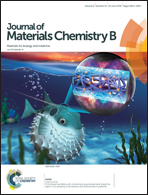Robust polymer nanofilms with bioengineering and environmental applications via facile and highly efficient covalent layer-by-layer assembly†
Abstract
This work reports novel, robust, multifunctional covalent-bonded polymer nanofilms based on highly efficient spin-assisted layer-by-layer (LbL) assembly, with a wide range of engineering and bioengineering applications. An active-ester block copolymer, polypentafluorophenylacrylate-block-polystyrene (PPFPA-b-PS), and an amine-rich polymer, branched polyethyleneimine (PEI), were chosen as model polymers. The as-prepared nanofilms show switchable hydrophobicity with controllable thickness. Nanomechanical tests demonstrate that the surface adhesion between the PPFPA-b-PS and PEI layers facilitates excellent film stability under different solvent conditions. Robust and centimeter-scale freestanding nanofilms with good transparency and excellent flexibility could be readily obtained by peeling the films from their silicon substrates without using a sacrifice layer. More importantly, the multi-layer nanofilms containing free pentafluorophenol groups or amine groups can be readily functionalized further to tailor the properties of the films for various applications. As a proof of concept, a multi-layer nanofilm with free ester groups was modified with rhodamine-6G hydrazone and tested as a H+ sensor. The free amine groups in the polymer nanofilms show strong interactions with perfluorooctanoic acid for achieving high surface hydrophobicity. The polymer nanofilms also show exceptional tunable cell-attachment behavior by switching the outmost layer between PPFPA-b-PS and PEI, demonstrating great potential for biomedical applications.



 Please wait while we load your content...
Please wait while we load your content...